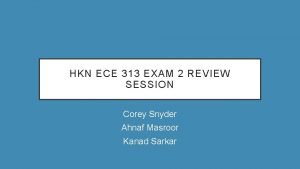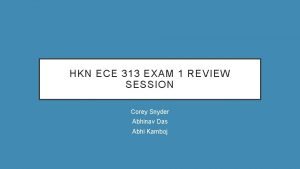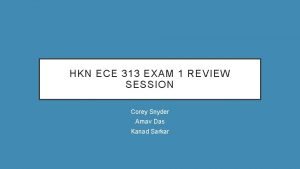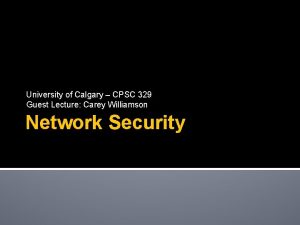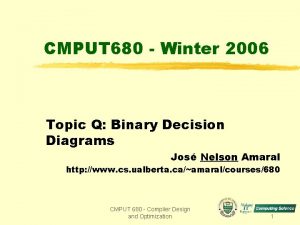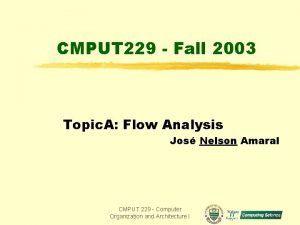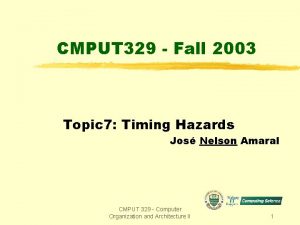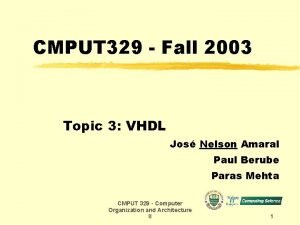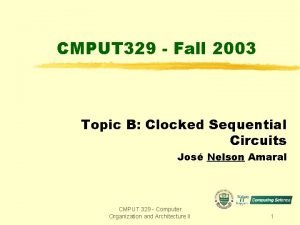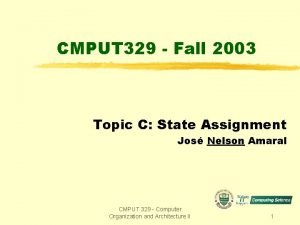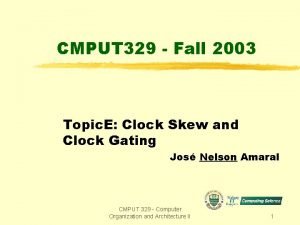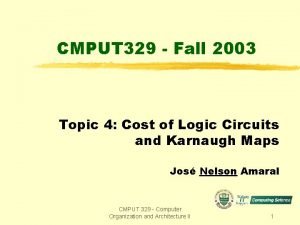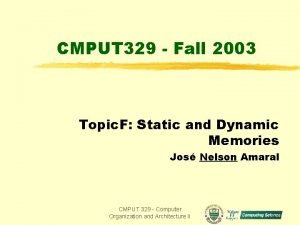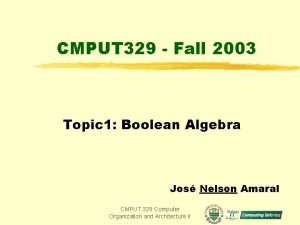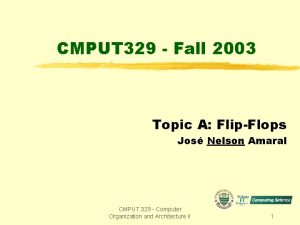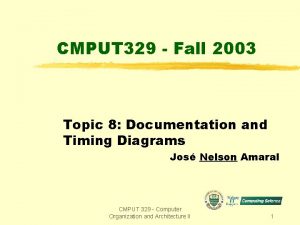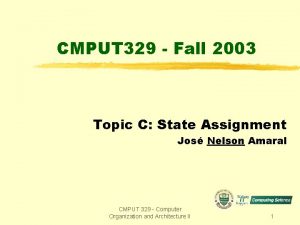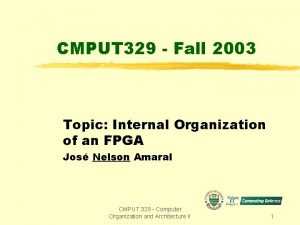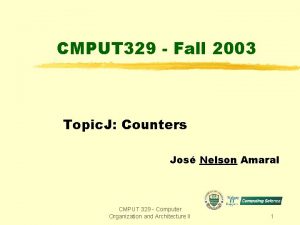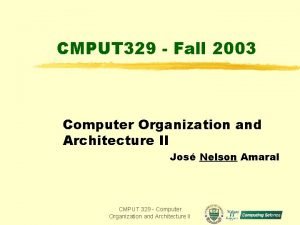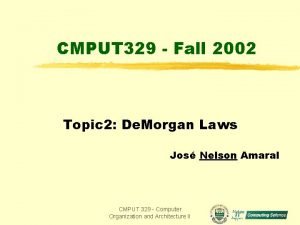CMPUT 329 Fall 2003 Topic 7 Timing Hazards

















- Slides: 17

CMPUT 329 - Fall 2003 Topic 7: Timing Hazards José Nelson Amaral CMPUT 329 - Computer Organization and Architecture II 1

Reading Section 4. 5 (Wakerly Textbook) CMPUT 329 - Computer Organization and Architecture II 2

Hazard haz-ard (noun) A chance of being injured or harmed; danger: Space travel is full of hazards. A possible chance of danger: fire hazard. (tr. v. ) To expose to danger or harm. (Middle English hasard), dice game, from Old French, possibly from Old Spanish azar, possibly Arabic az-zahr, the gaming die : al-, the + zahr, gaming die. ] CMPUT 329 - Computer Organization and Architecture II 3

Circuit’s Behavior The steady-state behavior of a circuit is the value of the output after the inputs have been stable for a long time. The transient behavior of a circuit is the value of the output while (or soon after) the inputs change. The glitch is a (often undesirable) short pulse produced in the output during a transient phase. If a circuit has the possibility of producing a glitch, the circuit has a hazard. CMPUT 329 - Computer Organization and Architecture II 4

Static-1 Hazard A static-1 hazard is a set of two input combinations Xa and Xb such that: (i) Xa and Xb differ in only one input variable; (ii) both Xa and Xb produce a 1 output; but it is possible for a momentary 0 to appear in the output when the input transits from Xa to Xb or from Xb to Xa i. e. , a static-1 hazard is a possibility of a 0 glitch when we expect a steady 1 output. CMPUT 329 - Computer Organization and Architecture II 5

Static-0 Hazard A static-0 hazard is a set of two input combinations Xa and Xb such that: (i) Xa and Xb differ in only one input variable; (ii) both Xa and Xb produce a 0 output; but it is possible for a momentary 1 to appear in the output when the input transits from Xa to Xb or from Xb to Xa i. e. , a static-0 is a possibility of a 1 glitch when we expect a steady 0 output. CMPUT 329 - Computer Organization and Architecture II 6

Example X Z Y 1 1 0 Z’ 0 1 XZ’ 0 1 YZ 1 0 1 Does this circuit have a hazard? If so, of what kind? F 1 0 1 The hazard occurs in the transition from X, Y, Z = 111 to X, Y, Z = 110 Z Z’ YZ XZ’ F CMPUT 329 - Computer Organization and Architecture II 7

Static Hazards in Karnaugh Maps X Z F Y F = X • Z’ + Y • Z X 1 Z 1 1 Y 1 How can we identify a static-1 hazard in this Karnaugh map? Two adjacent 1’s that are not in the same term cause a static-1 hazard. CMPUT 329 - Computer Organization and Architecture II 8

Static Hazards in Karnaugh Maps X Z F Y F = X • Z’ + Y • Z X 1 Z 1 1 Y 1 How can we eliminate the hazard? We can add one extra term to F. F = X • Z’ + Y • Z + X • Y CMPUT 329 - Computer Organization and Architecture II Consensus Term 9

Static Hazards in Karnaugh Maps X Z F Y F = X • Z’ + Y • Z X X 1 Z 1 1 Y 1 How can we eliminate the hazard? We can add one extra term to F. F = X • Z’ + Y • Z + X • Y CMPUT 329 - Computer Organization and Architecture II Consensus Term 10

Another Example W 1 Y 11 W 1 1 1 1 1 Z Y 1 X 1 1 1 1 1 Z 1 X F = W’ • Z + X • Z’ + X’ • W 1. Write minimal form for F 2. Identify static-1 hazards 3. Eliminate static-1 hazards CMPUT 329 - Computer Organization and Architecture II 11

Another Example W 1 Y 1 W 1 1 1 1 1 Z Y 1 X 1 1 1 1 1 Z 1 X F = W’ • Z + X • Z’ + X’ • W + X • W’ 1. Write minimal form for F 2. Identify static-1 hazards 3. Eliminate static-1 hazards CMPUT 329 - Computer Organization and Architecture II 12

Another Example W 11 1 Y W 1 1 1 1 1 Z Y 1 X 1 1 1 1 1 Z 1 X F = W’ • Z + X • Z’ + X’ • W + X • W’ + W • Z’ 1. Write minimal form for F 2. Identify static-1 hazards 3. Eliminate static-1 hazards CMPUT 329 - Computer Organization and Architecture II 13

Another Example W 1 Y 1 W 1 1 1 1 1 Z Y 1 X 1 1 1 1 1 Z 1 X F = W’ • Z + X • Z’ + X’ • W + X • W’ + W • Z’ + X’ • Z 1. Write minimal form for F 2. Identify static-1 hazards 3. Eliminate static-1 hazards CMPUT 329 - Computer Organization and Architecture II 14

Dynamic Hazards A dynamic hazard is the possibility of an output changing more than once as the result of a single transition. Dynamic hazards exist when there are multiple paths with different delays from the changing input to the changing output. Dynamic hazards do not occur in properly designed two level AND-OR or OR-AND circuits. PS: A two level AND-OR or OR-AND circuit is properly design if a variable and its complement are never input to the same first level gate. CMPUT 329 - Computer Organization and Architecture II 15

Dynamic Hazard Example 0 W 0 X Y slow 0 Z 1 1 0 0 1 1 slower CMPUT 329 - Computer Organization and Architecture II 16

Dynamic Hazard Example 0 W 0 1 X Y slow 0 Z 1 0 1 0 1 0 1 slower A dynamic hazard occurs when oscilation may occur when a single transition is expected. CMPUT 329 - Computer Organization and Architecture II 17




